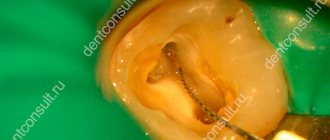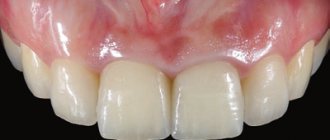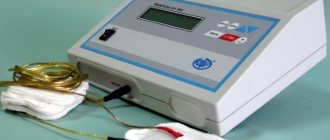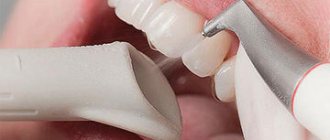Microscope - luxury or necessity?
Harry Kahr, who was the first to use a microscope in dental treatment, briefly and clearly substantiated the principle of its necessity: “You can only treat what you can see.” With traditional treatment, the doctor’s “view” is limited to what is reflected in the dental mirror, while the microscope intended for dental treatment has a thirty-fold magnification, making the examination of the surface of the tooth and its internal structure more detailed and complete. This not only allows the doctor, who normally works almost by touch, to better see the area being treated, but also reduces the amount of living tissue removed during drilling, and also reduces to zero the risk of “looking through” a carious cavity or an uncleaned canal.
Indications and contraindications
This service is necessary in the following cases:
- inflammation of the pulp that occurs
- due to the defeat of a pathogenic
- microflora;
- trauma to the tooth and jaw;
- deep caries damage
- long-term lack of treatment;
- periodontitis is extensive inflammation of the root membrane.
Contraindications include:
- pregnancy;
- inflammatory processes in the oral cavity, including stomatitis;
- leukemia;
- psychical deviations;
- cardiovascular diseases;
- infectious hepatitis.
The price of the service depends on the patient’s condition and the extent of damage to the tissues of the pulp, dentin, roots and their membranes. You will receive accurate information during a face-to-face consultation with a doctor. Don't put off visiting the dentist; the longer you wait, the more expensive the treatment will be.
Is it necessary to use a microscope when treating tooth canals?
The use of a microscope can be justified both in diagnosis and in the treatment of teeth and gums, equally in surgery, therapy, periodontology, dental restoration, and orthodontics. However, where the use of a microscope cannot be avoided, it is in endodontics - the treatment of dental canals. Each tooth has from one to three (in rare cases, four) canals, the diameter of which is on average 1 millimeter - a value barely visible to the naked eye. In addition, dental canals have bends and branches; a doctor can see them in detail, and therefore fully treat them, only under magnification, otherwise he will act by touch or “by the picture” - an enlarged image from an x-ray.
What does an endodontist treat?
Most often, the endodontist has to treat pulpitis and/or inflammation of the bone around the tooth root - apical periodontitis. If you don't pay enough attention to restoring the health of the bone around a tooth, you can eventually lose that tooth altogether. Also, if you do not treat the tooth canal for pulpitis very carefully, the infection remaining inside will eventually lead to periodontitis. The circle closes, and the patient is forced to see a doctor again. Thus, it is better and more effective to immediately treat all diseases associated with tooth canals with an endodontist. This way you will save both your health and money.
What are the indications for dental treatment under a microscope?
If an X-ray examination shows the presence of a large number and complex structure of dental canals, the use of a microscope becomes simply necessary. Also, one hundred percent indication for the use of a microscope is retreatment of canals. Previously, when it was discovered that endodontic treatment was carried out poorly or not in full (and the signal indicating this was, as a rule, acute pain), the tooth had to be immediately removed. Today, it has become quite possible to unfill, re-treat and re-fill tooth canals, and all this is thanks to the use of a microscope. One of the common complications of endodontic dental treatment in the past was root canal perforation. This happened when a doctor, drilling “by touch,” accidentally drilled through the tooth tissue, leaving a hole inside that provoked inflammation and ultimately led to the removal of the injured tooth. Today, the risk of perforation is reduced through the use of a microscope when processing canals, and if this does occur during traditional endodontic treatment, the situation can be quickly corrected using the same dental microscope.
Another unpleasant moment, which, alas, was the norm ten or even five years ago, is the fragments of the instrument left in the canals when the nerves were removed, as well as fragments of the nerves themselves. The microscope here equally helps both to prevent the occurrence of such a problem and to eliminate it. Another undeniable breakthrough made thanks to the introduction of microscopy into widespread dental practice is the ability to treat granulomas and cysts in a tooth without removing the latter.
We welcome you, our dear patients. In this publication we would like to highlight the topic of endodontic dental treatment and the closely related use of an operating dental microscope in the clinic. First, let's define the term endodontics. Surely you have heard this word more than once when visiting a dental clinic. So what is endodontic treatment?
In fact, everything is simpler than it seems at first glance, the answer is hidden in the word itself: “endo” - inside, “dont” - tooth, that is, this is the area of dentistry that deals with intervention inside the tooth in cases where this is indicated. What's inside? The “inside” of the tooth is the pulp, which is a vascular-nervous tissue – popularly known as the “nerve of the tooth.”
True, this is not only nervous tissue, it is also full of an abundance of blood vessels and is responsible for the sensitivity and blood supply of the dental organ. Visually it resembles a very small, sometimes microscopic, piece of meat. So, this neurovascular tissue is present inside the crown of the tooth and then from the bottom of the crown spreads into the root or several roots, forming the root canal(s) system of the tooth.
When is root canal treatment required?
Indications for endodontic treatment are cases where caries was not treated in a timely manner and has spread so deep inside the tooth that it has caused inflammation of the nerve, which may not necessarily be accompanied by symptoms; chronic inflammation of the nerve often develops, which may not manifest itself for a long time until it worsens this inflammatory process. But when this exacerbation occurs, it manifests itself in very severe pain that literally does not allow you to sleep. Even if this does not force a person to seek help from a dentist, then the inflammation in the nerve and the infection that caused it spreads beyond the root into the bone surrounding the root of the tooth, and further along the vascular bed can spread further. In a similar scenario, inflammation and infection spread beyond the root of the tooth into the bone tissue if the inflamed nerve for some reason was not completely removed from the tooth.
What can be done to prevent this from happening, or if such a situation already exists, can it be corrected? YES!! In such cases, it is required - high-quality endodontic treatment or retreatment. This is a procedure for removing the nerve from the crown and passing through the root canals (in the case of re-treatment: removing the material previously introduced from the root canals, passing through the untreated part of the canal) followed by disinfection!! and hermetic sealing. It would seem that it sounds elementary)), however, there are again “buts” here! The root canal is not just a straight hollow tube from which a small piece of meat is pulled out and voila! Unfortunately, everything is much more complicated here: the canals of the tooth are a network of branches in the volumetric microspace of the root, which must be extracted from there in order to achieve high-quality endodontic treatment.
The number of canals in a tooth may not be regulated; there may be additional hard-to-reach narrow canals that the clinician must find, pass through, and expand to a certain size in order to properly rinse and obturate it.
Another catch is that the diameter of the channel is only a few tenths of a millimeter, sometimes hundredths, plus it is not straight and may have bends in several planes. Sometimes, a doctor who deals with endodontic treatment faces a difficult task. Considering the fact that the instrument used to treat the root canal also has a small diameter and needs to pass through bends, it can break off directly in the canal, which can be a complication of the endodontic procedure and an obstacle to further treatment of the canal.
About microscopic endodontics
Due to the fact that fine precision manipulations are required in endodontics, the direction of microscopic endodontics (endodontic treatment procedure using an operating microscope) has gained relevance and development. I would like to convey to you the essence of the use of this technology in dentistry, quoting one of the famous American endodontist Garry B. Carr: “human hands can perform manipulations with much greater accuracy than even the most keen human eye can see.”
What is the difference between conventional root canal treatment without magnification and treatment under a microscope?
The biggest advantage of root canal treatment using a microscope is the magnifying optical function of the dental microscope, which allows the specialist to examine the tooth and its root canals under multiple magnification (maximum 30x). In this way, areas that are not visible to the naked eye can be examined, which significantly increases the success and effectiveness of treatment. Regardless of whether we are talking about a manual or mechanical method of cleaning root canals, the entire intervention becomes extremely precise. Even root canal fillings can be performed more accurately.
Coaxial illumination: a special LED built into the microscope head illuminates the surgical field. This direct illumination provides excellent visibility for the specialist to examine all the details of the problem area. If in the procedure of conventional endodontic treatment the dentist, for the most part, is forced to rely on his manual sensations, in treatment under a microscope the doctor performs targeted manipulations, visualizing the process.
The advantages that the use of a dental operating microscope gives us:
- carrying out accurate diagnostics. Increased awareness at the diagnostic level directly leads to increased treatment effectiveness. For example, cracks are often invisible at a macroscopic level, but when they are held under high-power optics, they become noticeable.
- treatment is carried out at various levels of magnification up to 30x using powerful coaxial LED illumination of the working field
- the quality and success of treatment is largely higher due to the high resolution optical power of the dental microscope, which allows the clinician to cope with complex cases of root canal treatment (- Finding hidden, hard-to-reach canals - Bypassing/removing fragments of instruments - removing blockages of root canals, etc.)
- loss of tooth tissue is minimized, treatment can be performed through a small approach, which minimizes the risk of tooth fracture/crack
- problematic teeth that have previously undergone endodontic treatment but continue to cause problems can be preserved, thus avoiding tooth extraction
- both the doctor and the patient can monitor the progress of treatment on a special monitor.
In what cases may root canal treatment under a microscope be required?
- If the pain does not go away after conventional root canal treatment and your tooth continues to cause complaints, it is very likely that there is an undetected, uncleaned/undisinfected root canal or some part of it. These root canals are usually not visible to the naked eye. With the help of microscopic magnification it is possible to detect and clean them.
- to preserve teeth that were recommended for removal due to the ineffectiveness of previously performed interventions in the canals
- if the root canal is too narrow or curved and cannot be cleaned during normal treatment
- if the landmarks and topography of the root canals are not visible to the naked eye, in the case when calcified tissue is deposited inside the tooth, which closes the gaps and mouths of the root canals, erasing any landmarks for their search
- in difficult cases of removing an old root filling
- if surgical instruments were broken in the root canal during a previous treatment and need to be removed.
Thus, thanks to the use of a microscope, our endodontist specialists can carry out successful interventions even in those complex and problematic cases where general dental practice is no longer sufficient!
Taking care of your health, in the trend of modern technologies, Your Dent-Time. We are waiting for you at our reception with our faithful assistant Leica M320.
In what other cases is a dental microscope used?
Endodontics is the most common and most justified use of such expensive equipment as a microscope, but its field of application is not limited to root canal treatment alone. It is absolutely fair to say that with a microscope is always better than without it. Even in standard caries treatment, the use of a microscope greatly increases efficiency and reliability, and also provides guarantees of long-term results. For example, detecting caries at the initial stage, when its treatment can be carried out without using a drill and removing a large amount of tissue, is almost impossible with the naked eye, especially in hard-to-reach places; A microscope provides such an opportunity.
Photo of a tooth under a microscope
Using technology to eliminate oral diseases
Treatment under a microscope is a revolutionary technology that allows you to eliminate serious dental pathologies without surgical removal.
For example, before the advent of dental optics, teeth with poor root canal patency had to be removed. The same applied to pathologies such as cysts and granulomas. Thanks to the microscope, the tumor can be removed without cutting the gums, that is, the operation becomes less traumatic for the patient’s body.
Doctors use optical equipment in the treatment of pulpitis, periodontitis and other diseases that require pulp removal. If there is a suspicion of perforations, fractures of the root and crown of the tooth, it is also recommended to carry out treatment under magnification.
What are the features of dental treatment under a microscope?
If you decide to use a microscope in your treatment, your appointment with the dentist will proceed as follows: firstly, you will be in a lying position and not sitting, as is the case with traditional treatment; secondly, the doctor will be behind your head or sitting almost on the same level as you to your right, and the microscope itself will be located at a distance of 20 - 25 centimeters from your face. The use of a microscope in treatment means that the doctor will work with it constantly, rather than look into it from time to time. In this case, the image from the camera equipped with the dental microscope will be transmitted to the monitor of the assistant, who controls the treatment process and provides the doctor with the necessary tools and preparations.
Benefits of tooth nerve removal at Dr Klaus Berg
German pedantry, high quality materials and adherence to technology - such factors have allowed our dentistry to earn the trust of many patients.
How a tooth is treated with nerve removal in our company:
- painless;
- with careful monitoring of each stage of the procedure;
- without negative consequences under any initial circumstances;
- quickly - in one visit;
- at a reasonable price.
Other dental, care and disease prevention services are also offered. We provide a three-year guarantee for the services provided, but this is not the only reason why you should contact our clinic:
- System of cumulative discounts. Allows our clients to save up to 15% of their budget.
- Positive reputation. Over 10 years of work, we have formed an extensive client base, the trust of whose members we have earned. New patients often come to us on someone else's recommendation.
- Collaborative planning. A council of doctors gathers to discuss difficult cases. We strive to choose the safest treatment option for the patient with the most successful prognosis.
If you need tooth nerve removal at a competitive price in Voronezh, contact Dr. Klaus Berg. You can make an appointment through the official website of the clinic or by phone.
Where is it possible to undergo dental treatment under a microscope in Moscow?
Unfortunately, today not all dentists in Moscow have a dental microscope. This is due not only to the high cost of such equipment, but also to the need for specialized training for doctors to work with such equipment. Therefore, if at the diagnostic stage such complications-fraught features as branched dental canals or the possibility of a dental cyst were discovered, it is worth asking whether the dentistry of your choice allows dental treatment under a microscope. If this is not possible, you should think about looking for another clinic and a doctor with appropriate competence. Any conscientious dentist, even if he is not able to independently carry out dental treatment under a microscope, if there is an urgent need for it, will advise you to go to a dentistry that has such an opportunity.
Stages of the procedure
To remove nerves, the doctor must:
- numb the tooth;
- “open” the crown with a drill, assess the degree of development of pathological processes;
- using special instruments, remove nerve tissue from the canals;
- fill the canals and restore the tooth body with technological materials.
Modern clinics do not use arsenic, which was previously in demand for killing nervous tissue. Its use is not safe; it can also affect healthy tissue. In addition, this outdated method takes more time - the final stage, mechanical extraction of the nerve, is not carried out at the first visit to the doctor. Arsenic should act until the expected effect occurs within a week.
At the clinic Dr. Klaus Berg, the entire procedure is carried out in one visit; an experienced doctor performs it in 40-60 minutes. The cost of tooth treatment with nerve removal is affordable - from 2,500 rubles. There is no risk of damage to healthy tissue, and there is no negative impact of toxic arsenic on the patient’s health.
Ophthalmological component
Let’s immediately discard all statements that a microscope spoils vision; in fact, it is the only instrument that preserves it.
When working without a microscope, during the convergence of the eyes, constant contraction and tension of m occurs on the object. medial rectus. And this does not go away without a trace - with prolonged stress, fatigue increases due to constant tension, and after a while it is difficult for the doctor to concentrate (Fig. 7).
When working with a microscope, our gaze is directed to infinity; convergence is taken over by the optical part of the microscope (Fig. 8), therefore, when working with a microscope, we can perform more complex manipulations longer and more accurately.









